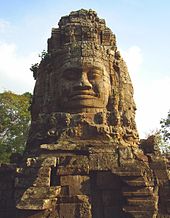Ta Prohm

The Ta Prohm building complex is an abandoned temple complex in Cambodia consisting of a temple , a monastery , other smaller buildings and the surrounding wall with corner towers and gopurams (entrance pavilions). It is located about two kilometers northeast of Angkor Wat , the most famous and largest temple in the Angkor area .
History and religious significance
Ta Prohm was built from the late 12th to the 13th century under the reign of King Jayavarman VII. Later expansions were made under King Indravarman II. The original name was "Rajavihara" ( Sanskrit ), which also denoted the use: the royal monastery . Although Jayavarman VII and his mother, to whom he dedicated the complex, were Buddhists , Ta Prohm has a large number of reliefs with depictions from Hindu mythology ( Krishna , Vishnu , from the Ramayana, etc.). After completion, 260 gods and goddesses were worshiped in the sanctuaries. The temple was consecrated in 1186 in honor of Prajnaparamita , the Buddhist concept of the "perfection of wisdom". Like many of the temple complexes in Angkor, Ta Prohm is an example of the syncretism of the Khmer population of that time .
A remarkable representation shows the departure of Siddhartha Gautama , the future Buddha , from the house of his parents and his hometown. He rides a horse, with many gods carrying its legs to muffle the noise of the hooves so that Gautama can begin his search unnoticed.
architecture
The outer boundary wall of the complex encloses an area of about 60 hectares , of which the temple and the buildings surrounding it only take up one hectare. Beyond the outer wall there were around 3,140 villages with a total of 80,000 inhabitants. Mainly monks lived on the site itself. A temple inscription indicates their number as 12,640.
As everywhere in Angkor, buildings made of stone were reserved for religious purposes. The people, including the king, lived in wooden houses. That is also the reason why only the temples survived the centuries, while all secular buildings fell victim to the tropical and humid climate.
Ta Prohm was built in the early Bayon style, the most striking feature of which are towers with faces of the Bodhisattva Lokeshvara , often several meters high .
Ruins and strangler figs
Ta Prohm occupies a special position among the temple complexes of Angkor and in the plans of visitors because of its half-ruined state. The restorers and architects of the École française d'Extrême-Orient (EFEO), the first to begin restoring temples in modern times, decided to leave a temple as it was when they found it. The choice fell on Ta Prohm. The vegetation and the fallen bricks were only removed and secured to the extent that visitors were able to walk through the facility. The strangler figs ( Ficus virens ) and the even larger Tetrameles nudiflora , whose roots overgrown entire buildings, are particularly impressive .
Others
The ruins were used as the backdrop for the film Lara Croft: Tomb Raider .
Pictures by Ta Prohm
literature
- Freeman, Michael and Jacques Claude: Ancient Angkor . Asia Books, Bangkok 1999. ISBN 974-8225-27-5 .
- Roveda, Vittorio: Khmer Mythology . River Books, Bangkok 1997, 1998, 2000. ISBN 974-8225-37-2 .
Web links
Coordinates: 13 ° 26 ′ 5.5 ″ N , 103 ° 53 ′ 20.8 ″ E









